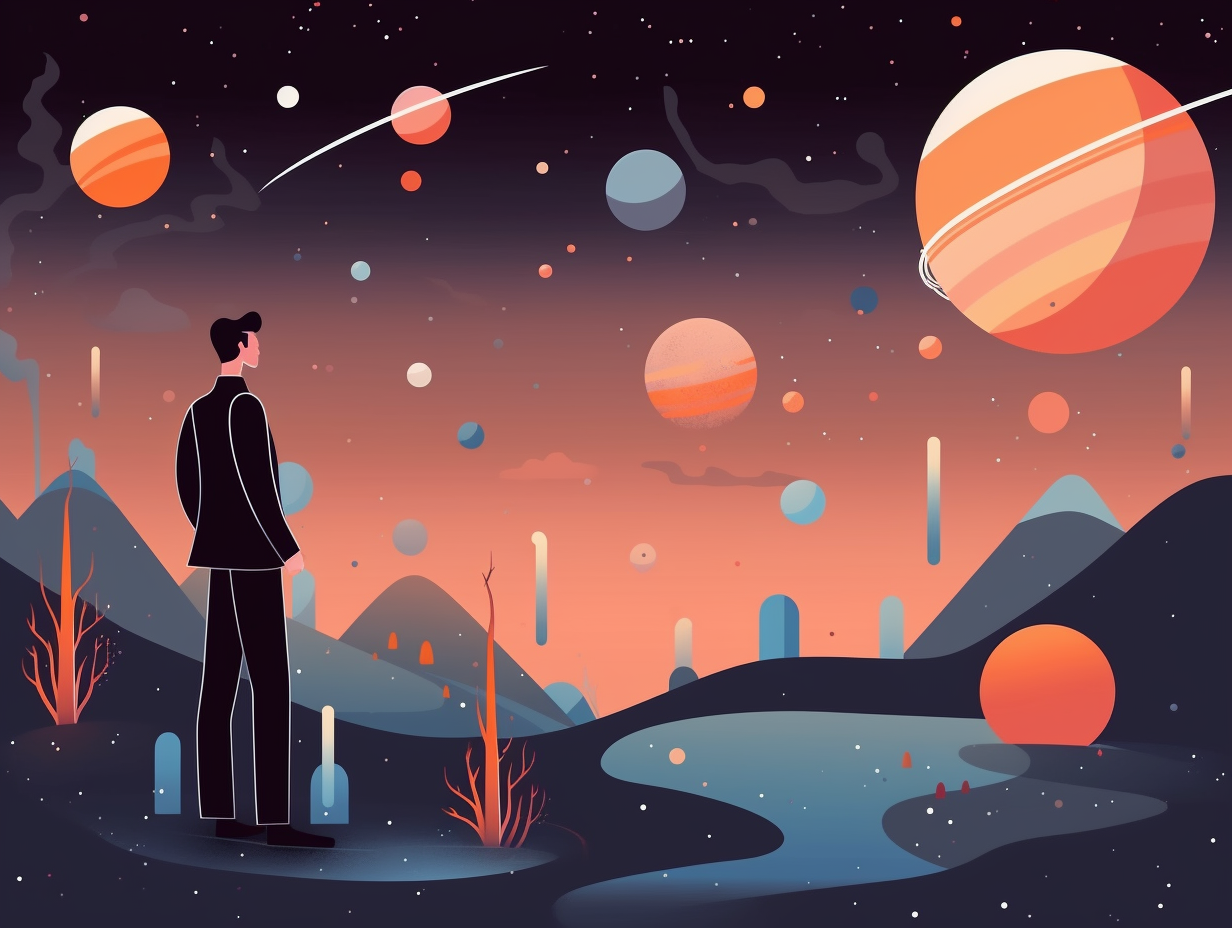23 Mind-Blowing Fun Facts About Black Holes That Will Astound You

1. Black Hole Couples Therapy
Why did the star go to couples therapy? To deal with its relationship to a black hole! In more scientific terms: black holes can be indirectly detected through their gravitational effects on surrounding stars, and this has recently revealed the presence of dark matter in black hole binary systems.
Source => space.com
2. Lonely Black Holes
Feeling singularly lonely? Wait till you hear about black holes: These enigmatic cosmic donut-devourers don't actually contain singularities, avoiding mathematical meltdowns and leaving scientists to ponder what truly lurks within their gravitational clutches.
Source => wtamu.edu

Did you know that bread crumbs are a major threat in space? Discover how tortillas save the day on the ISS and learn about astronauts' unique taste bud adventures!
=> Fun Facts about Space
3. The Great Black Hole Diet
Despite their penchant for gobbling up cosmic goodies like a toddler let loose in a candy store, black holes surprisingly won't be joining any weight-watchers' clubs anytime soon: Eventually, every black hole will evaporate away through Hawking radiation, with smaller black holes poofing out of existence in under a second.
Source => forbes.com
4. Gravitational Lensing Waving
Ever tried staring into the abyss and having it wave back at you? Black holes have this magical way of creatively bending light to say "Hello!": This stunning optical illusion, known as gravitational lensing, was first predicted by Einstein's theory of general relativity and has been observed numerous times, with the most recent example being the glowing donut-shaped ring captured by the Event Horizon Telescope, showcasing a black hole's gravity bending light into a dazzling show.
Source => pbs.org

5. The Cosmic Vacuum Cleaner
Black holes: the ultimate vacuum cleaners of space, gobbling up cosmic debris and making even the bravest planets quiver in their orbits! Seriously though: they grow by consuming surrounding matter such as gas, dust, and even stars, with some forming through the merger of smaller black holes, ultimately leading to the creation and growth of new stars.
Source => news.uchicago.edu
6. M87's Dance Moves
M87's got a mean twerk: The celestial dance move of black hole Messier 87, also known as Powehi, has it spinning at a jaw-dropping speed that barely shy of the speed of light, a phenomenon called superluminal motion, confirmed by data from the Chandra X-ray Observatory.
Source => businessinsider.in
7. Black Hole Evictions
Even black holes get evicted from their galactic homes: When two galaxies merge and their supermassive black holes combine forces, they release an energy equivalent to 100 million supernovas exploding all at once, effectively flinging the newly formed black hole from its cozy galactic center and into the vast universe, forever.
Source => phys.org
8. SMBH Speed-dating
If supermassive black holes were at a speed-dating event, they'd skip the small talk and go straight to business: these astronomical heavyweights aren't formed by smaller black holes playing the dating game and merging together, but rather through direct gas cloud collapse or a less-than-romantic mass accumulation over eons! Who knew that these cosmic beasts could be so non-dramatic? : The simple fact is, every large galaxy has a supermassive black hole in its midst, and they have masses up to billions of times that of the Sun; failing fickle courtships and comet-swaps, it's the slow-and-steady, gassy growth that takes home the crown.
Source => en.wikipedia.org
9. Cosmic DJs Remixing Gravity
Black holes: the cosmic DJs spinning records out of spacetime. They don't just remix gravity; they make it wobble and wave when they join forces on the dance floor: In a groundbreaking model incorporating nonlinear gravitational wave propagation effects, researchers discovered unique frequencies and interactions when black holes collide and merge. This could eventually lead to better testing of whether general relativity is still cutting the rug as the reigning theory of gravity around these celestial party animals.
Source => space.com

10. Picky Eater Black Holes
Black holes: the universe's picky eaters who won't swallow just any celestial broccoli! Gentleman jesters of cosmic dining, these massive misfits defy popular belief and follow their own dietary guidelines: consuming a relatively small portion of their own mass, with the highest recorded black hole munching on a mere one solar mass every two days, or about 183 solar masses annually.
Source => public.nrao.edu
11. Stars Turned Noodle Soup
Next time you see a black hole, you might want to tell it to keep its hands to itself! As it turns out, these cosmic vacuum cleaners have a habit of turning stars into noodle soup: when a star drifts too close to a black hole, the intense gravity stretches it into a long, glowing spaghetti of hot gas, which then orbits the black hole, forming a disk that can outshine entire galaxies – all in just weeks or months!
Source => scitechdaily.com
12. Cosmic Sneezing Galaxies
Have you ever sneezed so hard that the rest of the universe said "Bless You" and then ghosted you for eternity? Well, some galaxies might just understand that feeling: Turns out, black holes aren't the only ones with event horizons – the point of no return where even light can't escape. The universe's expansion is so quick, it's causing galaxies beyond a certain distance to disappear from our view forever, as they too cross an event horizon, never to be seen again.
Source => britannica.com
13. Ton 618: Size Matters
Move over, cars and mountains, you've been seriously outmassed: The largest ultramassive black hole, Ton 618, weighs in at an awe-inspiring 66 billion times the mass of our Sun, effortlessly proving that size does matter when it comes to celestial gobblers that could fit multiple solar systems within their cosmic embrace.
Source => nerdist.com
14. Black Hole Heavy Metal Forges
Who said money doesn't grow on trees – or rather, cosmic monsters: Black holes can create heavy metals like gold and platinum by facilitating excess neutron formation within an accretion disk of hot, dense matter orbiting around a newborn black hole, ultimately serving as celestial forges for these valuable elements.
Source => theswaddle.com

15. Black Hole's Unending Party
Did you hear about the black hole's party? Nobody could leave, not even the light: This is because black holes have an event horizon which acts as the point of no return, drawing in everything, including light, with their immense gravitational pull.
Source => astronomy.com
16. Hawking's Quantum Culinary Concoctions
Whoever said "there's no such thing as a free lunch" never met Stephen Hawking and his culinary concoctions of cosmic proportions: Hawking radiation, a type of radiation emitted by black holes, was theorized by the renowned physicist, and recent research suggests that, contrary to previous beliefs, information about the initial state of a black hole is preserved during evaporation, keeping the information paradox a hot topic in quantum gravity studies.
Source => en.wikipedia.org
17. Black Hole's Cosmic Kitchen
When black holes get "hangry," they like to cook up a storm in their own cosmic kitchen known as the accretion disk: This swirling mass of celestial ingredients heats up, producing electromagnetic radiation that emits a unique color and allows scientists to learn more about black holes and their appetites.
Source => medium.com
18. Superpowered Spitball Game
Beware the wrath of black holes, for they have the universe's most potent spitball game: These cosmic heavyweights can launch jets of material at velocities verging on the speed of light, shooting them straight out from their event horizons like an interstellar sneeze. M87*, the first black hole to flash their fanged mug in a photograph, demonstrates this breathtaking talent — a mystery that continues to keep scientists on the edge of their seats, eager to uncover its secrets.
Source => livescience.com
19. Dyson Spheres: Galactic Raves
Forget solar power; black holes are the new cosmic energy drink, just waiting to fuel up some Type II Kardashev party animals: By constructing a Dyson sphere mega-structure around a black hole, these advanced civilizations could harness insane amounts of energy, although we'd spot their groovy galactic dance floor through infrared light via telescopes like the Sloan Digital Sky Survey and the Wide Field Infrared Survey Explorer. So far, no cosmic energy bars have been found, but the search for a black hole-propelled rave continues!
Source => scitechdaily.com
20. Penrose Process Magic Trick
Hold onto your hats and glasses, folks: a cosmic magic trick is about to defy science's favorite party pooper, gravity! Thanks to the astronomical hustle known as the Penrose process, dark matter particles around black holes can actually escape and produce detectable gamma rays, thus providing a thrilling opportunity for scientists to study the elusive dark matter that makes up a whopping 80% of the universe.
Source => space.com
21. Black Hole Time Travel
Forget the DeLorean – we've got black holes for your time-traveling needs: Spend one year hanging out by a black hole, and you'll fast-forward 80 years in Earth-time due to the slower ticking of clocks near black holes compared to those on our planet.
Source => astronomy.com
22. Black Hole Cosmic Decorators
When black holes aren't busy gobbling everything up like a hungry teenager after sports practice, they're one heck of cosmic decorators, ripping stars to shreds and creating an interstellar light show worth writing home about: These ravenous cosmic creatures can tear a star apart and rearrange its matter into accretion disks, lighting up the night sky as an active galactic nucleus and dazzling the universe with their brilliance, even outshining entire galaxies in the process.
Source => forbes.com
23. Cataclysmic Black Hole Duet
Hold onto your hats and intergalactic horizons, for the cosmic opera is about to reach its cataclysmic crescendo, with a stellar duet that'll make even the heavens tremble: when two black holes merge, they unleash gravitational waves that pack a thousand times more power than all the stars in the visible universe combined, leaving behind a symphony of spacetime vibrations detected only by the watchful eyes of LIGO and LISA.
Source => americanscientist.org
Related Fun Facts




















